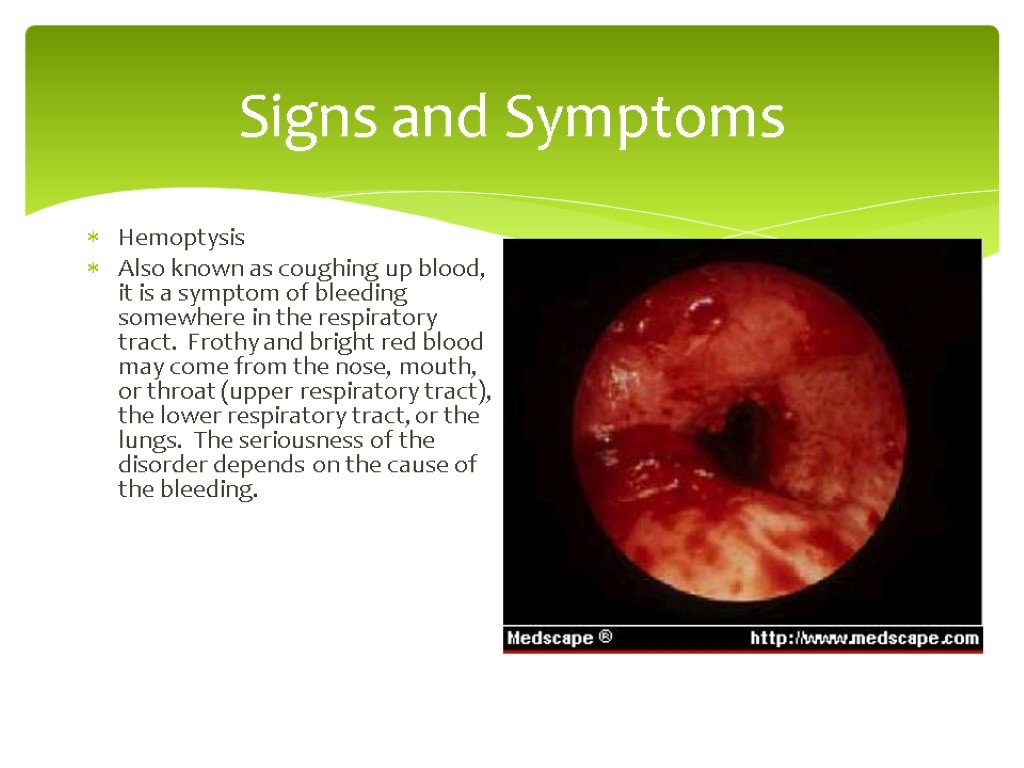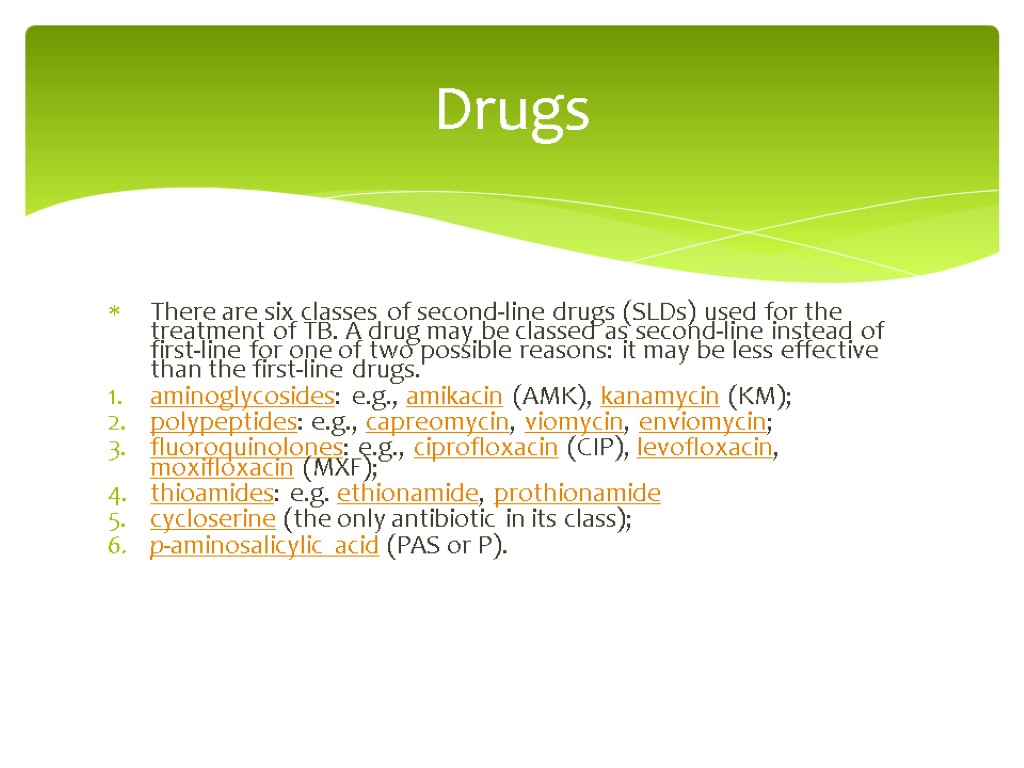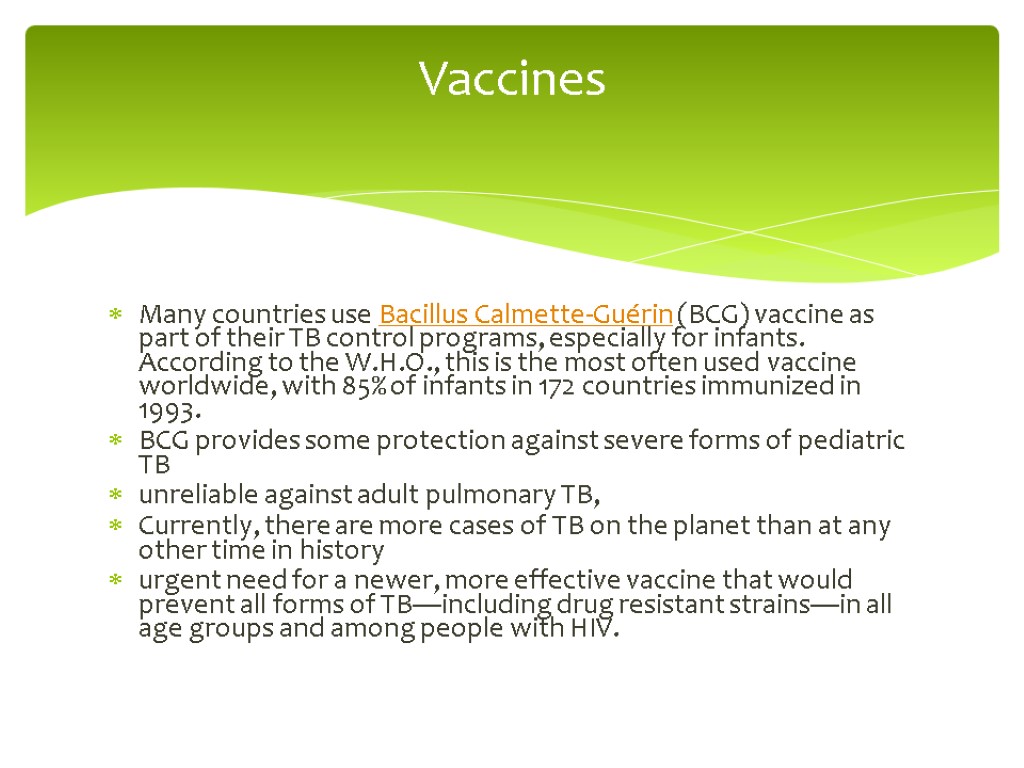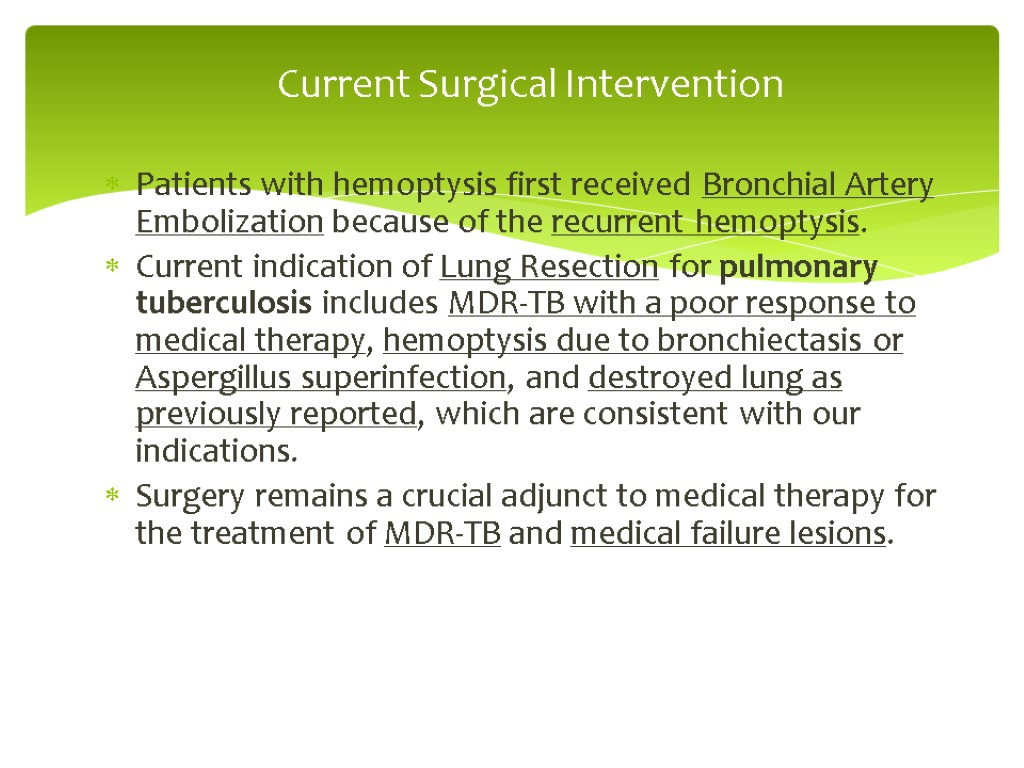Pulmonary Tuberculosis KAZAKH NATIONAL MEDICAL UNIVERSITY NAMED AFTER


Pulmonary Tuberculosis KAZAKH NATIONAL MEDICAL UNIVERSITY NAMED AFTER S.D. ASFENDIYAROV GROUP: GM13 – 038 - 01 DONE BY: Sima Waizi

Pulmonary Tuberculosis Tuberculosis is a common and often deadly infectious disease caused by mycobacteria, mainly Mycobacterium tuberculosis. Tuberculosis usually attacks the lungs (as pulmonary TB).

Pulmonary Tuberculosis Scanning electron micrograph of Mycobacterium tuberculosis

According to the World Health Organization (WHO), nearly 2 billion people—one third of the world's population—have been exposed to the tuberculosis pathogen. Annually, 8 million people become ill with tuberculosis, and 2 million people die from the disease worldwide. In 2004, around 14.6 million people had active TB disease with 9 million new cases. The annual incidence rate varies from 356 per 100,000 in Africa to 41 per 100,000 in the Americas. Tuberculosis is the world's greatest infectious killer of women of reproductive age and the leading cause of death among people with HIV/AIDS. Epidemiology

Most common infectious cause of death worldwide Latent phase of TB enabled it to spread to one third of the world population 8,000,000 new cases each year 3,000,000 infected patients die Epidemiology

Epidemiology

When people suffering from active pulmonary TB cough, sneeze, speak, or spit, they expel infectious aerosol droplets 0.5 to 5 µm in diameter. A single sneeze can release up to 40,000 droplets. People with prolonged, frequent, or intense contact are at particularly high risk of becoming infected, with an estimated 22% infection rate. A person with active but untreated tuberculosis can infect 10–15 other people per year. Others at risk include people in areas where TB is common, Transmission

Transmission

people who inject drugs using unsanitary needles, residents and employees of high-risk congregate settings, medically under-served and low-income populations, high-risk racial or ethnic minority populations, children exposed to adults in high-risk categories, patients immunocompromised by conditions such as HIV/AIDS, people who take immunosuppressant drugs, and health care workers serving these high-risk clients. Transmission

Pathogenesis

Diagnostics Inject intradermally 0.1 ml of 5TU PPD tuberculin Produce wheal 6 mm to 10 mm in diameter Represent DTH (delayed type hypersensitivity)

Chest Radiography Abnormalities often seen in apical or posterior segments of upper lobe or superior segments of lower lobe May have unusual appearance in HIV-positive persons

No chest X-ray pattern is absolutely typical of TB 10-15% of culture-positive TB patients not diagnosed by X-ray 40% of patients diagnosed as having TB on the basis of x-ray alone do not have active TB Chest radiography

Obtain 3 sputum specimens for smear examination and culture Persons unable to cough up sputum induce sputum bronchoscopy gastric aspiration Follow infection control precautions during specimen collection Specimen Collection

overall diagnostic yield for sputum examination related to the quantity of sputum (at least 5 mL) the quality of sputum multiple samples obtained at different times to the laboratory for processing 3 samples obtained at least eight hours apart with at least one sample obtained in the early morning Number of sputum samples required

Strongly consider TB in patients with smears containing acid-fast bacilli (AFB) Results should be available within 24 hours of specimen collection Presumptive diagnosis of TB Not specific for M. tuberculosis Smear Examination

AFB smear Mycobacterium tuberculosis (stained red) in sputum

Cultures

Signs and Symptoms

Signs and Symptoms Hemoptysis Also known as coughing up blood, it is a symptom of bleeding somewhere in the respiratory tract. Frothy and bright red blood may come from the nose, mouth, or throat (upper respiratory tract), the lower respiratory tract, or the lungs. The seriousness of the disorder depends on the cause of the bleeding.

Signs and Symptoms Anorexia The sysmptom of poor appetite whatever the cause

The standard "short" course treatment for tuberculosis (TB), is isoniazid, rifampicin, pyrazinamide, and ethambutol for two months, then isoniazid and rifampicin alone for a further four months. The patient is considered cured at six months (although there is still a relapse rate of 2 to 3%). For latent tuberculosis, the standard treatment is six to nine months of isoniazid alone. If the organism is known to be fully sensitive, then treatment is with isoniazid, rifampicin, and pyrazinamide for two months, followed by isoniazid and rifampicin for four months. Ethambutol need not be used. Tuberculosis treatment

All first-line anti-tuberculous drug names have a standard three-letter and a single-letter abbreviation: ethambutol is EMB or E, isoniazid is INH or H, pyrazinamide is PZA or Z, rifampicin is RMP or R, Streptomycin is STM or S. Drugs

There are six classes of second-line drugs (SLDs) used for the treatment of TB. A drug may be classed as second-line instead of first-line for one of two possible reasons: it may be less effective than the first-line drugs. aminoglycosides: e.g., amikacin (AMK), kanamycin (KM); polypeptides: e.g., capreomycin, viomycin, enviomycin; fluoroquinolones: e.g., ciprofloxacin (CIP), levofloxacin, moxifloxacin (MXF); thioamides: e.g. ethionamide, prothionamide cycloserine (the only antibiotic in its class); p-aminosalicylic acid (PAS or P). Drugs

Drugs Daily Dose of TB Drugs

TB prevention and control takes two parallel approaches. In the first, people with TB and their contacts are identified and then treated. Identification of infections often involves testing high-risk groups for TB. In the second approach, children are vaccinated to protect them from TB. Prevention

Many countries use Bacillus Calmette-Guérin (BCG) vaccine as part of their TB control programs, especially for infants. According to the W.H.O., this is the most often used vaccine worldwide, with 85% of infants in 172 countries immunized in 1993. BCG provides some protection against severe forms of pediatric TB unreliable against adult pulmonary TB, Currently, there are more cases of TB on the planet than at any other time in history urgent need for a newer, more effective vaccine that would prevent all forms of TB—including drug resistant strains—in all age groups and among people with HIV. Vaccines

Patients with hemoptysis first received Bronchial Artery Embolization because of the recurrent hemoptysis. Current indication of Lung Resection for pulmonary tuberculosis includes MDR-TB with a poor response to medical therapy, hemoptysis due to bronchiectasis or Aspergillus superinfection, and destroyed lung as previously reported, which are consistent with our indications. Surgery remains a crucial adjunct to medical therapy for the treatment of MDR-TB and medical failure lesions. Current Surgical Intervention

Thank You
pulmonary-tuberculosis_s.ppt
- Количество слайдов: 29

